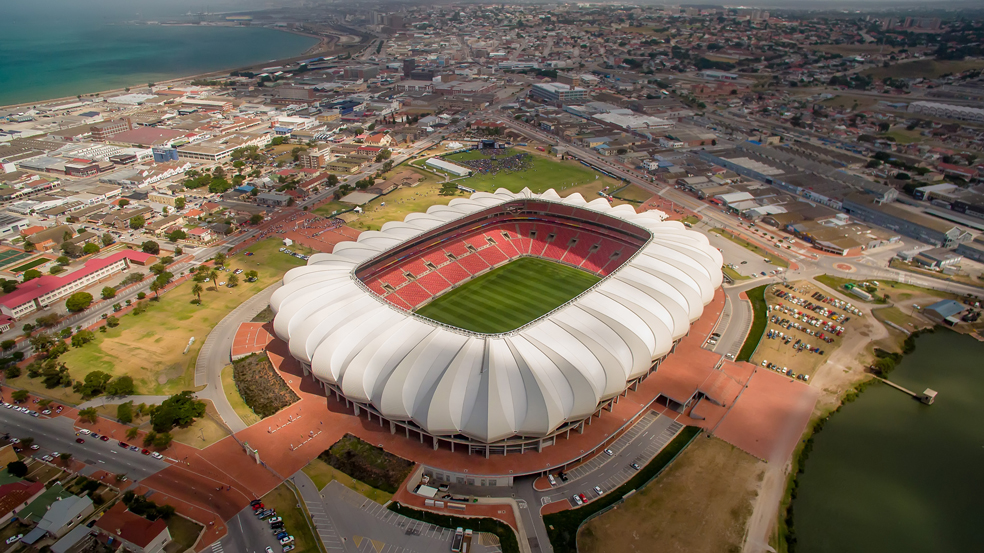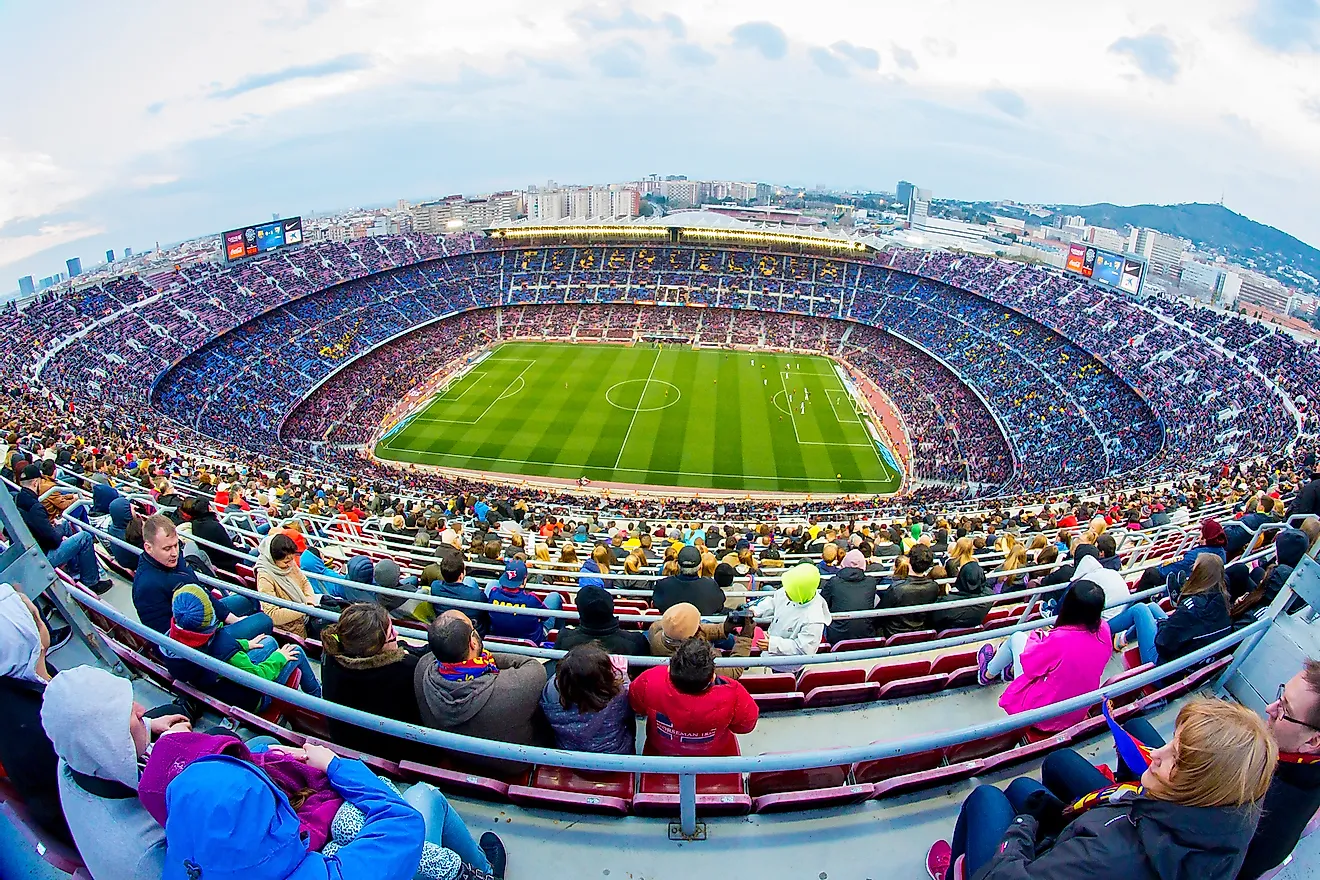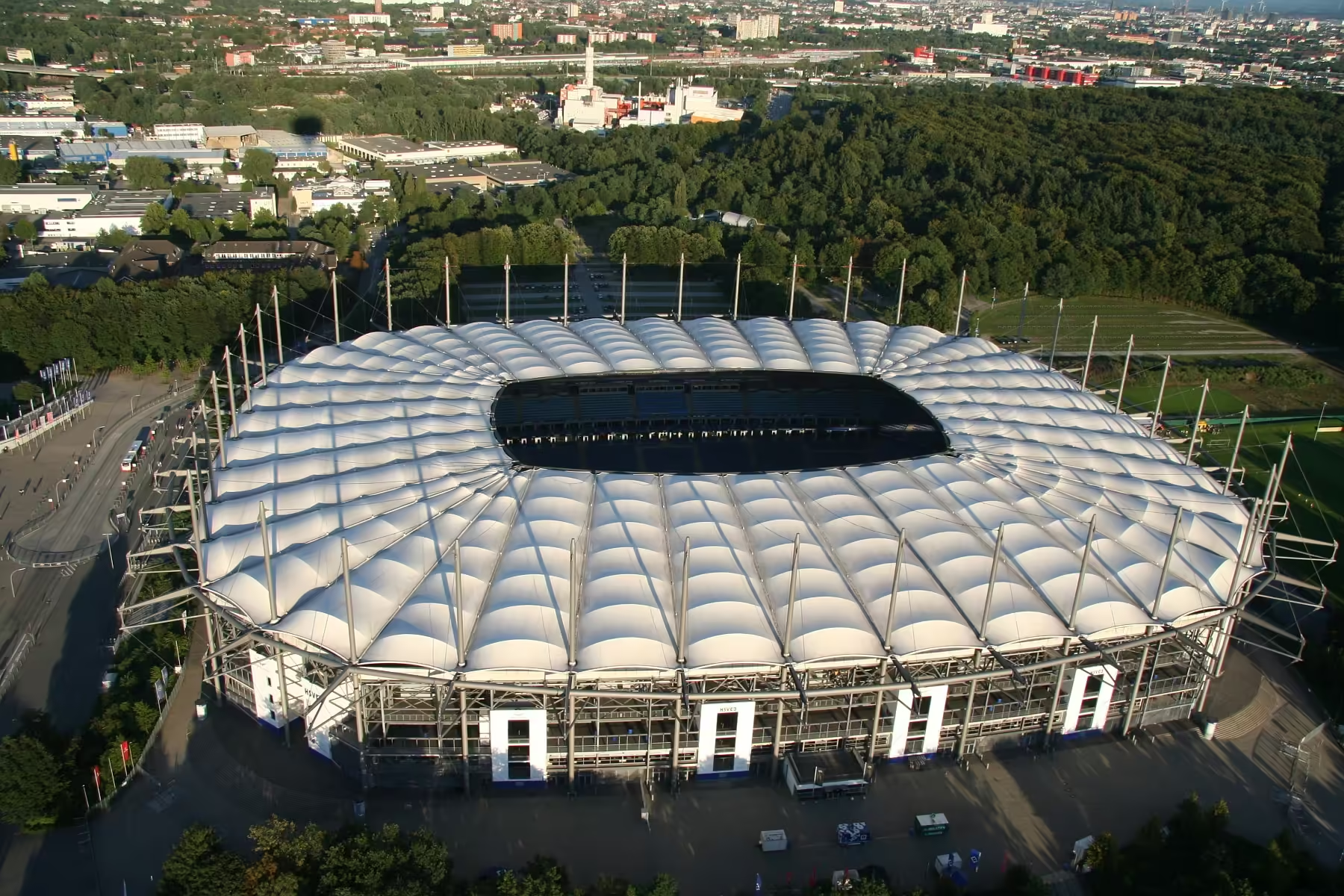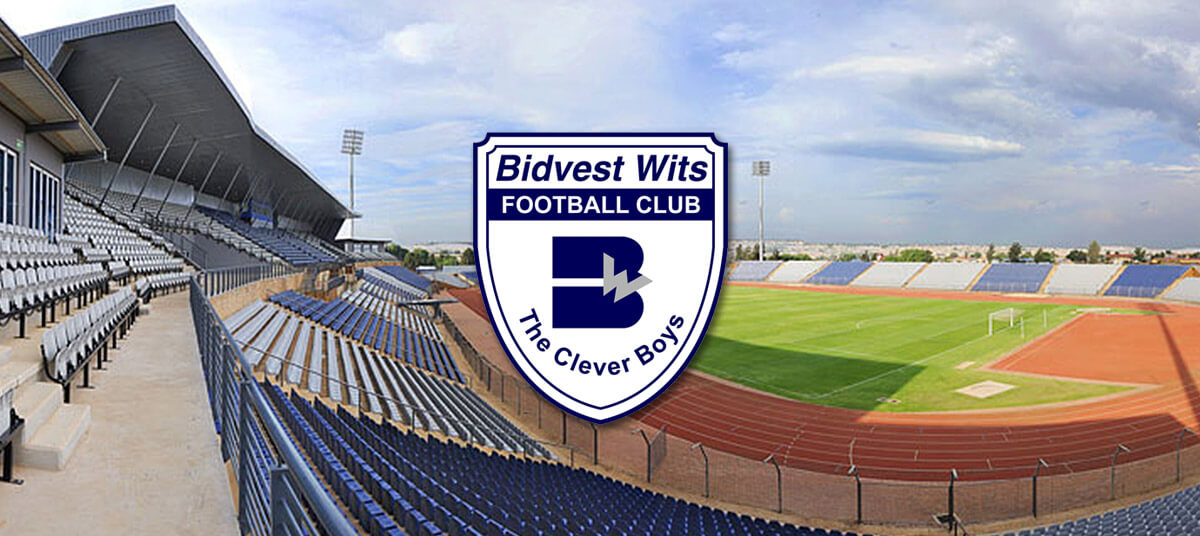Nelson Mandela Bay Stadium is one of the most iconic sports venues in South Africa. This world-class stadium is situated in Gqeberha (formerly known as Port Elizabeth) in the Eastern Cape province. It is a multi-purpose stadium that hosts various sporting events, including soccer and rugby union matches. The stadium’s striking design, state-of-the-art facilities, and rich history make it a must-visit destination for sports enthusiasts from around the world.
History and Construction The Nelson Mandela Bay Stadium was built for the 2010 FIFA World Cup, which was hosted by South Africa. The construction of the stadium began in 2006 and was completed in 2009. It was named after Nelson Mandela, the former President of South Africa and a global icon for peace and human rights. The stadium was designed to represent the shape of a flower, the Protea, which is South Africa’s national flower. It has a capacity of 46,000 seats and cost approximately R2 billion (around $159 million) to build.
Key Takeaways
- Nelson Mandela Bay Stadium is a world-class sports venue situated in Gqeberha, South Africa.
- The stadium was built for the 2010 FIFA World Cup and was named after Nelson Mandela.
- It has a capacity of 46,000 seats and cost approximately R2 billion to build.
History and Construction

The Nelson Mandela Bay Stadium, also known as the NMB Stadium, is a world-class soccer and rugby union stadium located in Gqeberha in the Eastern Cape province of South Africa. It was built to serve as one of the ten playing venues of the 2010 World Cup. The stadium officially opened on June 7, 2009, and hosted 2010 FIFA World Cup matches, including the third-place play-off.
Planning and Design
The stadium was designed by a consortium of architects, including German firm GMP Architekten and South African firm Louis Karol Architects. The design of the stadium was inspired by the African continent’s iconic flower, the Protea, which is also South Africa’s national flower. The architects incorporated the flower’s shape into the design of the stadium’s roof, which features five petals that curve upwards.
The stadium has a seating capacity of 46,000, with 34,000 seats on the lower tier and 12,000 on the upper tier. The stadium is equipped with state-of-the-art facilities, including a VIP lounge, a media center, and a players’ tunnel.
Building the Icon
The construction of the Nelson Mandela Bay Stadium was a massive undertaking, with a total cost of approximately R2 billion (approximately $159 million). The construction project was funded by the South African government, with the aim of creating a world-class venue that would showcase the country’s ability to host major international events.
The construction of the stadium began in March 2006 and took three years to complete. The construction process involved the excavation of 1.3 million cubic meters of soil and the pouring of 90,000 cubic meters of concrete. The stadium’s roof, which weighs approximately 4,000 tons, was assembled on the ground before being lifted into place by cranes.
Overall, the Nelson Mandela Bay Stadium is a testament to South Africa’s ability to create world-class infrastructure and facilities. The stadium has become an iconic landmark in the city of Gqeberha and a symbol of the country’s commitment to sports and development.
Significant Events and Milestones
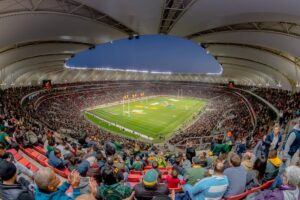
Inaugural Match
Nelson Mandela Bay Stadium was officially opened on June 7, 2009, with a friendly match between the South African national team and a team made up of players from the Nigerian and Argentine leagues. The match was attended by Nelson Mandela himself, who was 90 years old at the time, and who the stadium was named after. The match ended in a 2-2 draw, with South Africa’s Katlego Mphela scoring the first goal in the stadium’s history.
International Tournaments
The Nelson Mandela Bay Stadium has hosted several major international tournaments since its opening. The most significant of these was the 2010 FIFA World Cup, where the stadium was one of the ten venues used for the tournament. During the World Cup, the stadium hosted five group stage matches, a round of 16 match, and the third-place play-off.
The stadium has also hosted several international rugby matches, including the 2011 Tri-Nations Series match between South Africa and Australia, and the 2013 Rugby Championship match between South Africa and Argentina. In addition to this, the stadium has hosted several domestic rugby matches, including games played by the Southern Kings, a team that played in the Super Rugby competition between 2013 and 2017.
In conclusion, the Nelson Mandela Bay Stadium has played host to several significant events and milestones since its opening in 2009. From the inaugural match attended by Nelson Mandela himself to hosting matches during the 2010 FIFA World Cup, the stadium has cemented its place as an iconic sporting venue in South Africa.
Architectural Features
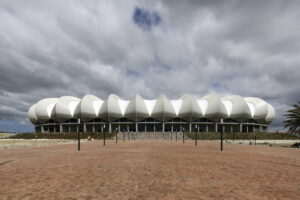
Stadium Design
The Nelson Mandela Bay Stadium is a five-tier, R2 billion (approximately $159 million) stadium that was built for the 2010 FIFA World Cup. The stadium is situated in Gqeberha in the Eastern Cape province of South Africa. It has a seating capacity of 46,000 and is home to Chippa United Football Club and formerly of rugby union team Southern Kings. The stadium was designed by German studio GMP Architekten, who also designed two other stadiums for the World Cup in South Africa.
The stadium’s design is inspired by the African continent’s traditional ‘imbawula’ or iron pot. The outer shell of the stadium is made of a translucent material called ETFE, which allows natural light to flood the stadium and provides a unique viewing experience. The stadium’s roof is supported by a series of steel arches that span the length of the stadium. The arches are designed to resemble the feathers of a bird, which is a symbol of freedom and unity in South Africa.
Sustainability and Innovation
The Nelson Mandela Bay Stadium is not just an architectural masterpiece, but it is also a sustainable and eco-friendly building. The stadium’s design incorporates various sustainable features, such as rainwater harvesting, natural ventilation, and solar power. The stadium has a system in place to collect rainwater from the roof and store it in underground tanks, which is then used for irrigation and flushing toilets. The stadium also has a natural ventilation system that uses the prevailing winds to cool the stadium.
The stadium’s solar power system consists of 1,600 solar panels that are installed on the roof of the stadium. The panels generate enough electricity to power the stadium’s floodlights and other electrical systems. The stadium’s innovative design and sustainable features have earned it numerous awards, including the Green Building Council of South Africa’s 6-star Green Star SA rating.
Community and Legacy
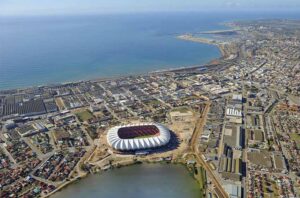
Economic Impact
The Nelson Mandela Bay Stadium has had a significant economic impact on the surrounding community. According to a report by Nelson Mandela Bay Municipality, the stadium generated R1.7 billion in economic activity during the 2010 FIFA World Cup. The report also states that the stadium has created jobs and stimulated the local economy through events and tourism.
Cultural Significance
The Nelson Mandela Bay Stadium is more than just a sports venue; it is a symbol of South Africa’s cultural heritage and a tribute to the country’s most beloved leader. The stadium was named after Nelson Mandela, who spent 27 years in prison fighting against apartheid. The stadium’s design was inspired by the protea, South Africa’s national flower, and its 46 petals are represented by the 46 years that Mandela spent fighting for freedom.
The stadium has also played host to a number of cultural events, including concerts and festivals, that celebrate South African music, dance, and art. These events have helped to promote the country’s rich cultural heritage and have brought people from all over the world to the stadium.
Overall, the Nelson Mandela Bay Stadium is a testament to the enduring legacy of one of the world’s most revered leaders. Its impact on the local community and its cultural significance make it a truly iconic venue.
Frequently Asked Questions
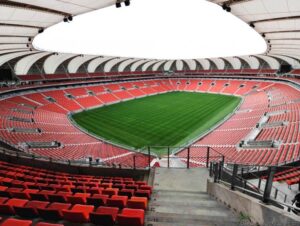
What events have been hosted at the Nelson Mandela Bay Stadium?
The Nelson Mandela Bay Stadium has hosted various events since its opening in 2009. It was built for the 2010 FIFA World Cup and hosted eight matches, including the third-place play-off. The stadium has also hosted several rugby matches, including the South African leg of the 2011 Tri-Nations Series, as well as music concerts and other sporting events.
Who was responsible for the design and architecture of the Nelson Mandela Bay Stadium?
The Nelson Mandela Bay Stadium was designed by a consortium of architects, including Gerkan, Marg and Partners (gmp), Louis Karol, and Motsamai. The stadium was inspired by the African continent’s iconic flower, the protea, and features a unique roof design that resembles a flower.
How does the capacity and size of Nelson Mandela Bay Stadium compare to other African stadiums?
The Nelson Mandela Bay Stadium is one of the largest stadiums in South Africa, with a seating capacity of 48,000. It is also one of the most technologically advanced stadiums on the African continent, featuring state-of-the-art facilities such as high-speed Wi-Fi, CCTV cameras, and LED scoreboards.
What were the significant milestones in the construction of Nelson Mandela Bay Stadium?
Construction of the Nelson Mandela Bay Stadium began in 2006 and was completed in 2009, just in time for the 2010 FIFA World Cup. The stadium was built at a cost of R2 billion (approximately $159 million) and features five tiers, with the upper tiers offering panoramic views of the city and the ocean.
Can you detail the sustainability features incorporated into the Nelson Mandela Bay Stadium?
The Nelson Mandela Bay Stadium was built with sustainability in mind, and several eco-friendly features were incorporated into its design. These include a rainwater harvesting system, which collects rainwater and uses it to irrigate the pitch and flush toilets, as well as energy-efficient lighting and cooling systems.
What are the future plans or upcoming events scheduled for the Nelson Mandela Bay Stadium?
The Nelson Mandela Bay Stadium continues to host various sporting events, including rugby and soccer matches. It is also a popular venue for music concerts and other cultural events. As of now, there are no significant upcoming events scheduled for the stadium.
Other Stadium Links:
Check Out: Twickenham Stadium: England’s Hallowed Ground of Sporting Majesty – Where Rugby Royalty Reigns
Check Out: Stade de France: Unveiling the Glorious Tapestry of France’s Sporting Heritage
Check Out: San Siro: Italy’s Iconic Shrine to Sporting Greatness – A Tale of Football Majesty
heck Out: Luzhniki Stadium: Moscow’s Monument to Sporting Heritage and Historic Triumphs
